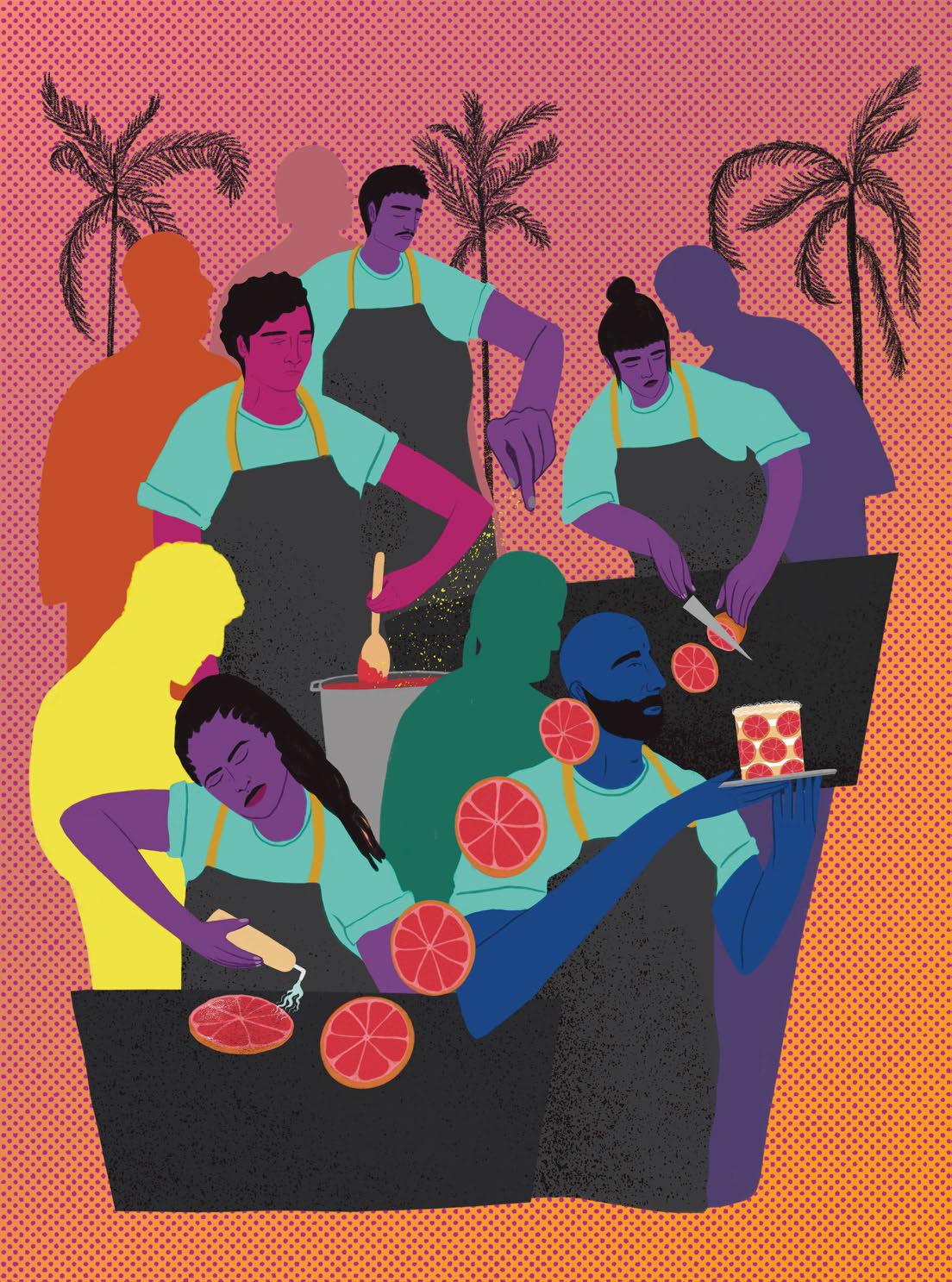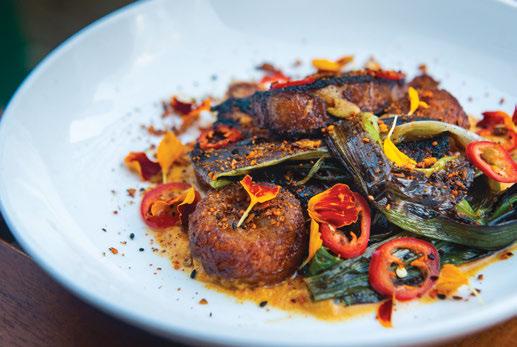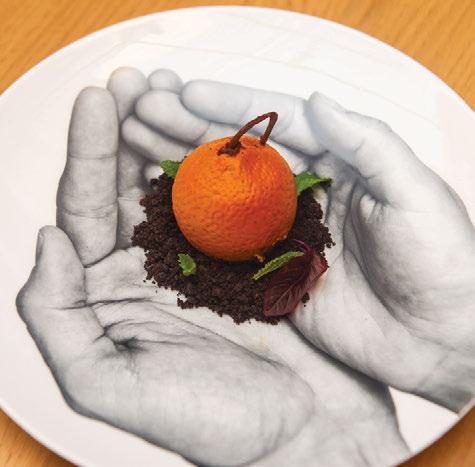
9 minute read
RESTAURATEURS
Randy Alonso, Chris Hudnall
2021 MIAMI
Advertisement
RESTAURATEUR AWARD
PRESENTED BY MONTAGUE
raaaaaaaaaandy / chudnall10 / lostboydrygoods
Randy
Most important rule in restaurant management: Always keep the glasses full. Most fun part of your job: Creating spaces that people get to share experiences in. Restaurant trend you’d like to see: I'd like to see restaurants/bars exploring more Sherry options on their menus. Restaurant trend you’re sick of: QR codes Advice to your younger self: I would tell myself to get into the hospitality industry sooner.
Chris
Most important rule in restaurant management: You don't need reworks and production to be successful. Focus on your product and your people (guests and sta culture). Most fun part of your job: e people Restaurant trend you’d like to see: I've always had a love for open- re kitchens. Watching the beauty and romance of cooking everything on open re intrigues me and makes me wonder why more chefs don't focus on mastering the skill. Restaurant trend you’re sick of: Deconstructing everything Advice to your younger self: You don't know everything—just listen.
LOST BOY DRY GOODS
e story of Lost Boy Dry Goods by Restaurateurs Randy Alonso and Chris Hudnall starts with the Downtown Miami neighborhood. In 1965, Alonso's father ed Cuba, where he owned a department store. He and Alonso's grandfather opened the store in a cavernous building on Flagler Street, steps away from where Lost Boy stands today.
Alonso studied engineering at Duke University but entered the family business in 2006. With a vision to build the neighborhood, he opened Lost Boy Dry Goods, a second store down the block that sold denim and cowboy boots. When the retail landscape changed, the family closed both stores. But after putting in so much work to make Downtown Miami a destination, Alonso didn't want to give up the denim shop space or the name. He'd always dreamed of having a bar but didn't know the business.
Enter Hudnall, a longtime hospitality professional from Arizona who began in the industry as a 16-year-old busser. In 2005, he started his hotel career with Morgans Hotel Group at the Mondrian Scottsdale. As the hotel struggled, he transferred to the Mondrian South Beach in 2008. Two years later, he led the opening beverage team at Soho Beach House. He became the North American director of bars in 2014. Additionally, he has consulted for restaurant groups, hotel operators, and commercial real estate developers.
Hudnall and Alonso founded Lost Boy in 2018, intending to become the neighborhood bar for people who love well-made cocktails and beer. eir next venture is a gin and tapas bar/ restaurant, Tropezón, coming this spring, in addition to six other openings scheduled through 2021.
RUSSO CHRISTINE PHOTO:

Cafe Americano
Bartender Derek Tormes of Lost Boy Dry Goods Adapted by StarChefs Yield: 1 cocktail
INGREDIENTS
Co ee-Rum Cordial:
17 grams whole Hawaiian co ee beans 200 grams dark Caribbean rum 100 grams sugar
To Assemble and Serve:
2 ounces Bu alo Trace bourbon 0.5 ounce Amaro Nonino 2 dashes orange bitters Orange expression Orange peel METHOD
For the Co ee-Rum Cordial:
Using a muddler, crack (not grind) co ee beans. Transfer co ee to a saucepan over medium-high ame and heat for 5 minutes or until co ee is nice and fragrant. Reduce heat and add rum; stir for 1 minute. Add sugar and stir until properly diluted. Remove from heat and cool. Strain into a nonreactive container.
To Assemble and Serve:
Add all ingredients and 0.5 ounces Co ee-Rum Cordial to a mixing glass and stir. Fill with ice, then stir until diluted. Strain into a rocks glass with 1 large ice cube. Garnish with orange expression and peel.
Featured ingredient: Bu alo Trace bourbon

THE NAME ON THE DOOR THE NAME ON THE NAME ON THE DOOR THE DOOR
BY KENDYL KEARLY ILLUSTRATED BY DANI DRANKWALTER
Marcus Samuelsson was not on board with the oxtail. Executive Chef (and Miami StarChefs Rising Star) Tristen Epps was trying to nail down a menu for Samuelsson’s newest restaurant, Red Rooster Overtown, and Epps was con dent in his wagyu oxtail, a shareable experience that runs for $105. Samuelsson argued that the dish might be too unfamiliar or expensive to the diner. But he’d never tasted it, so Epps put the wholeroasted oxtail on the menu anyway and hoped for the best. e stunt paid o when Samuelsson returned to Miami and sampled the brisket-like meat, punctuated by shaved black tru es and plantains. e oxtail stayed.
e role of executive chef under a big-name chef is usually a prestigious one but can also be associated with lack of creativity and pressure to live up to the brand. So how do you make a name for yourself when it’s not your name on the door? For Epps, the collaborative push and pull is part of what makes his relationship with Samuelsson so special. “ e compromise is where the beauty always lies,” says Epps, who built trust with his mentor through the years as sous chef of Red Rooster Harlem. Samuelsson sent him on tasting trips, helped him learn from other cuisines, and took the time to understand Epps’ own background.
“He knows my mom. He knows my girlfriend, my family, my upbringing,” Epps says. “I’m really open to what he has to say. It used to be whatever chef said went. Now, it’s more of a discussion, even an argument, but it’s two minds working instead of just one.”
At e Alley and LT Steak & Seafood, named for the famed Laurent Tourondel, Executive Chef Andrew Zarzosa caters to e Betsy Hotel guests with Tourondel’s menus featuring prime steaks, seafood, and pizzas. But Zarzosa has a constant rotation of specials and dinner events that are all his own, and he likes to reinterpret the Tourondel classics with local, seasonal ingredients.
“Whenever I choose to work, it’s always about the place, about what they’re doing, the potential to do more,” Zarzosa says. “I always want to learn something, and I always want to contribute something. I learn a lot from Laurent. [His menu] only helps me as a chef.”
For example, Tourondel’s menu taught Zarzosa to steam hen of the woods with aromatics before cooking. And sometimes, it’s Zarzosa who takes an idea further. LT had a char-broiled broccoli side dish, simple and meant to accompany the ashier entrees, but Tourondel’s technique gave Zarzosa an idea. He developed an elegant special starring char-broiled broccoli, deepfried orets, broccoli-lemon mousse, and black tru e.
mousse, and black tru e.
A large and heavily corporate restaurant structure can make these collaborations more di cult, but Ilkay Suuctugu, who is executive chef of the venerable Matador Room, takes ownership under JeanGeorges Vongerichten. When the season changes, she gathers a menu together featuring local ingredients, and Rising Stars alum Gregory Brainin, executive vice president of culinary development, works on building out the recipes with Vongerichten. “But it's up to me whether or not I want to utilize it,” Suuctugu says. “ en we talk about it, I send them pictures and recipes of my dishes, and we go back and forth to come to a nal decision. ey really have given me freedom.”
Rising Star Pastry Chef Samira Saade wants to stay with her mentor, pastry godfather Antonio Bachour, to learn as much as she can. “Antonio eats, sleeps, breathes pastry,” she says. At Bachour, it’s a collaboration among three instead of two. Saade keeps her sous looped into the brainstorming sessions because she often comes up with ideas that Saade can then replicate. ey supplement the classic desserts with new creations as Bachour gets bored with the menu.
Likewise, dessert-making is exacting but collaborative at
L’Atelier de Joël Robuchon
Miami. Head Baker Melissa Catra has to live up to the standards of Executive Pastry Chef Salvatore Martone, Culinary Director Alain Verzeroli, and the late Robuchon himself, whose name conjures expectations of Michelin stars.
“[Martone] was here this week, and he already has an idea about what to do [with a dessert], and we’ll bounce ideas back and forth,” Catra says. “ ere’s a creative process to it. You have to build it and see if it’s OK with a few trials and errors.” Martone usually starts with the basic concept, and Catra chimes in until they have the right balance of sweetness and acidity with seasonal ingredients.
Only a year into his post at e Betsy Hotel, Zarzosa reminds his peers to look at it from the other chef’s perspective. It’s his name on the door, so he’s the one with the nancial stake and reputation to uphold. e boss needs time to trust whoever is in charge of the kitchen.
"You go to work for a speci c chef for a reason,” Zarzosa says. “I really wanted to learn from [Tourondel]. Whether or not he gave me freedom or control, that was my understanding walking in. You learn what you can until it’s your name on the door.”
revamping the sour
orange By Amelia Schwartz photos by will blunt
Out of all the citruses in the Sunshine State, the sour orange might be the most overlooked. With their wrinkled skin and mouth-puckering bitterness, sour oranges are known for very few applications. In Miami, they are most often associated with mojo criollo, a Cuban marinade for grilled chicken or pork. It’s traditional for a reason, but with all its complexities and abundance of growth in Florida, the ugly little fruit is capable of so much more. ese two chefs have given sour oranges a new purpose.
Pork Belly with Sour-Orange-Persimmon Mojo
Pork and sour orange mojo are an obvious coupling, but Chef James McNeal of
Over/Under ips the pair on its head. Rather than marinating his Watson Farms pork belly in the mojo (recipe on page 84), he uses it as a jammy sauce. McNeal blends up charred, pork-fat-brushed persimmons with onion, thyme, Florida wild ower honey, and sour orange juice. e fragrant sauce sits beneath fried plantains, charred green onion, chiles, and McNeal’s jerk-spiced pork belly. e mojo plays an essential role, brightening up the pork’s melt-in-your-mouth umami.

Sour Orange Pie

e sour orange’s reputation with savory cuisine can hold chefs back from using it in pastry, but with a similar avor pro le to its key lime counterpart, McNeal’s con dent slice of sour orange pie proves that the fruit can belong in any course. He switches out the conventional graham cracker crust for one made of saltines and tops the sour orange cream with toasted meringue. ink an orange creamsicle with a sprinkle of zest.
The Foreign Orange
To Rising Star Chef Michael Beltran, sour orange is the avor that represents his childhood in Miami. “I have a thing with reinventing how people view the sour orange,” Beltran says. “My grandparents have a sour orange tree, and we used it every day.” e Foreign Orange, featured on Ariete’s tasting menu, is basically an ode to the bitter fruit and all things Miami. Beltran shapes foie gras mousse, sour orange gelée, and duck con t into an “ugly orange.” e intensely rich mousse is placed upon bitter charcoal and chocolate “dirt,” along with amaranth and mint leaves. Additionally, Beltran showcases sour oranges as a mouth-coating caramel over a plantain pavé with seared foie, demonstrating how varied the wrinkly fruit can be.












